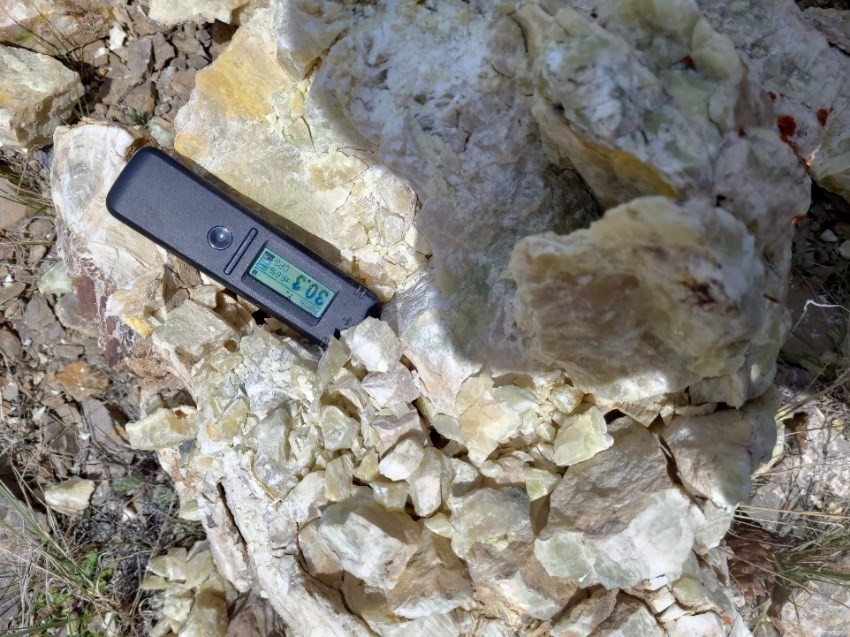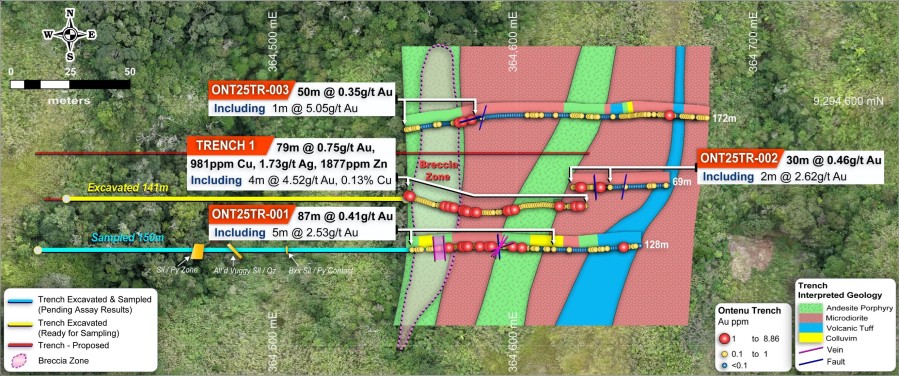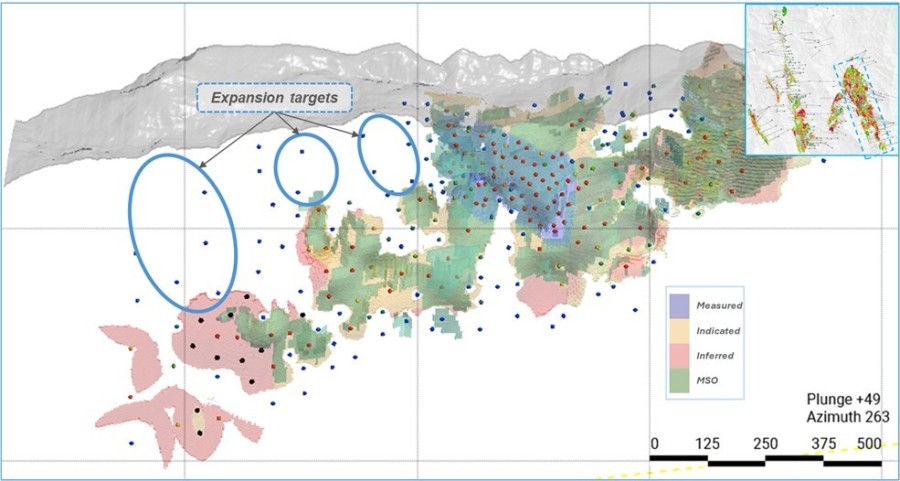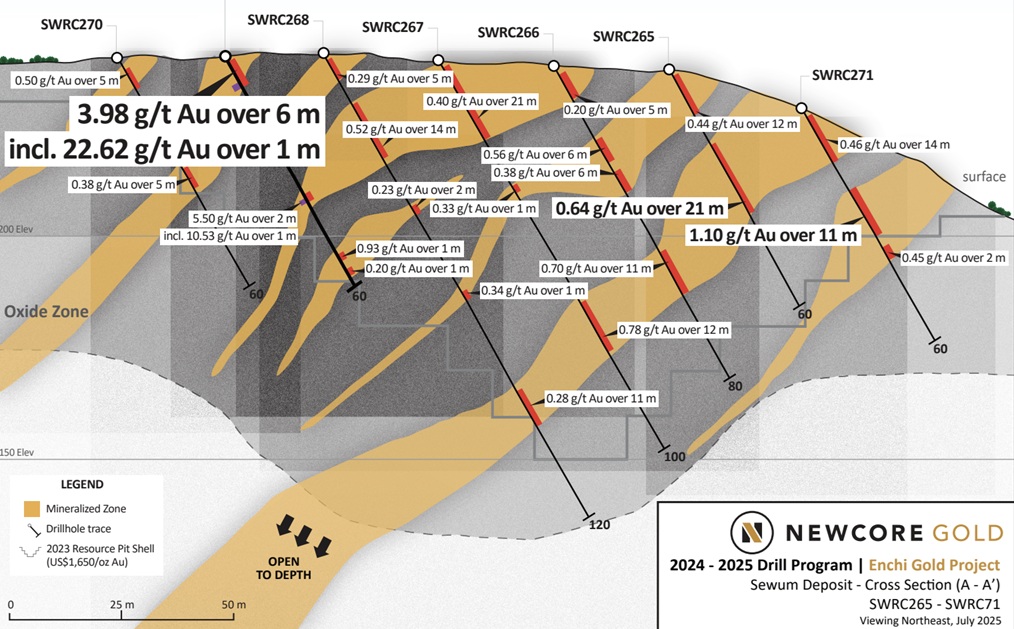Vancouver, British Columbia--(Newsfile Corp. - June 26, 2025) - U.S. Critical Metals Corp. (CSE: USCM) (OTCQB: USCMF) (FSE: 0IU) ("USCM" or the "Company") is pleased to report the successful completion of a geological field program at its Long Canyon Uranium Project, located in Lemhi County, Idaho (the "Project" or "Long Canyon"). The program included systematic mapping and geochemical sampling designed to evaluate areas hosting previously identified V-Mo-U-Ni-Zn mineralization in shale and limestone. The program also expanded into other areas with the objective of increasing the scale of the Project and developing a more regional perspective of the geologic systems present. USCM holds Long Canyon in partnership with IDEX Metals Corp. (for more information see Company's press release - access here).
Highlights:
- 251 rock samples were taken across the property and focused on altered and iron oxide-stained shale and gossanous limestone.
- Elevated scintillometer readings and visible mineralization observed in multiple black shale and carbonate horizons.
- Historical work has identified several faulted and folded, 20 to 30 meter thick black shale horizons in the Phosphoria Formation, which hosts many of the mineralized exposures.
- Additional attention was given to limestone-hosted mineralization which is comparable to the Phosphoria-hosted deposits of the Leadore District of Idaho about 75 kilometers north of the Project.
Management Commentary
Darren Collins, CEO of the Company, commented: "Initial field results from Long Canyon validate our belief in the district's potential to host multiple mineralization styles. These field observations demonstrate a compelling combination of structural complexity, prospective stratigraphy, and visible mineral indicators. The advancement of this project aligns with current Executive Orders of the US Federal Government, and we look forward to receiving assay data for this highly promising exploration project."
Field Program Observations
The field program focused on documenting the geologic framework enveloping mineralized (oxidized) horizons across the Project. The geologic team traversed the Project starting from identified mineralized areas and expanded outwards to trace the extent of these horizons. Across the property, several 20-30 meter thick intervals of structurally deformed black, carbonaceous shale units were documented in outcrop.
These units are distinguished by dark coloration, elevated organic content, localized zones of oxidation, and elevated radiation levels as confirmed by handheld scintillometer readings in the field. This unit is host to historically documented uranium-vanadium occurrences, including uranium up to 521 ppm in rock chip and grab samples and 3,985 ppm in soil samples (for more information, see Company's press release - access here). The black shale units have a strike length of approximately three kilometers; however, the unit is noted to pinch and swell and may disappear beneath shallow tertiary cover. The extent of these prospective black shale units is defined and assays are pending.
The team also documented gossanous carbonate outcrops on elevated ridges within the project area. These exposures display strong hematite and manganese oxide staining and are spatially associated with steeply dipping fault structures. The surface alteration features observed are consistent with those seen in carbonate hosted Ag-Pb-Zn deposits. In one location, a historic adit exceeding 20 meters in length was identified along a ridge, which hosts oxidized carbonate material. While the adit was not safely accessible, its presence and alignment with alteration zones are consistent with historical Ag-Pb-Zn exploration.
Further work is required to ascertain the origin of mineralizing fluids. However, carbonate-hosted deposits (CRD) are known to exist in Eastern Idaho and include the Leadville, Gilmore mine, and Viola mine. No sulfide mineralization was directly observed in outcrops on the Project during the current program, but dump material contained noticeable galena.
Over the course of the program, 251 rock samples were taken across the property. Assay results are pending.
 Photo 1: Radiation detector reading 30.3 counts per second (cps) on a large float sample (60 x 30 cm) found in an old road cut. The massive, greenish-yellow rock, possibly marble or a vein material, may host uranium-bearing minerals such as autunite, suggested by the elevated radioactivity.
Photo 1: Radiation detector reading 30.3 counts per second (cps) on a large float sample (60 x 30 cm) found in an old road cut. The massive, greenish-yellow rock, possibly marble or a vein material, may host uranium-bearing minerals such as autunite, suggested by the elevated radioactivity.
 Photo 2: Chip sample collected across a 1.5 m black shale outcrop exposed in a road cut, returning 25.0 cps on a handheld radiation detector. The outcrop displays strong manganese and iron oxide staining, finely laminated bedding, and vivid black, purple and red banding-features characteristic of black shale-hosted uranium and vanadium systems.
Photo 2: Chip sample collected across a 1.5 m black shale outcrop exposed in a road cut, returning 25.0 cps on a handheld radiation detector. The outcrop displays strong manganese and iron oxide staining, finely laminated bedding, and vivid black, purple and red banding-features characteristic of black shale-hosted uranium and vanadium systems.
 Photo 3: The black shale outcrop from which the previous sample was collected, showing well-developed bedding and deep oxidation along fractures and surfaces. This exposure highlights the scale and continuity of mineralized horizons observed in the chip sample, with visual cues such as manganese-rich staining and vivid color banding supporting the potential for shale-hosted uranium-vanadium mineralization.
Photo 3: The black shale outcrop from which the previous sample was collected, showing well-developed bedding and deep oxidation along fractures and surfaces. This exposure highlights the scale and continuity of mineralized horizons observed in the chip sample, with visual cues such as manganese-rich staining and vivid color banding supporting the potential for shale-hosted uranium-vanadium mineralization.
 Photo 4: Subcropping grey-blue fissile silty shale exposed in a historic trench. The unit exhibits patchy limonitic staining, clay-filled fractures, and minor quartz-carbonate veining. Radiation readings peaked at 188 cps, supporting the potential for uranium enrichment within structurally prepared shale horizons.
Photo 4: Subcropping grey-blue fissile silty shale exposed in a historic trench. The unit exhibits patchy limonitic staining, clay-filled fractures, and minor quartz-carbonate veining. Radiation readings peaked at 188 cps, supporting the potential for uranium enrichment within structurally prepared shale horizons.
A Radiacode 102 handheld gamma spectrometer was used during the field program to assist in identifying areas of elevated radioactivity for mapping and sampling purposes. The device is equipped with a CsI(Tl) scintillation crystal and a silicon photomultiplier (SiPM), with a detection range of approximately 30 keV to 3 MeV and energy resolution of ~7.5% at 662 keV. The spectrometer provides both real-time count rates and spectral gamma data. The unit was newly purchased for the program and operated under the manufacturer's default calibration settings. No third-party or field-specific calibration was performed. Radiometric measurements were used qualitatively to support field observations and guide geological sampling but were not used in any assay reporting or resource estimation.
Executive Order
Given the political shift to deglobalize and secure domestic sources of supply, the program is strategically timed to capitalize on the sweeping US federal directive to expand nuclear energy and reform uranium permitting processes in the US, as set forth in the Executive Order released on May 23, 2025 (for more information see Executive Order - access here). Long Canyon is well positioned given it has the hallmarks of a polymetallic shale-hosted system to benefit from these initiatives. With the U.S. federal government actively dismantling regulatory roadblocks to domestic uranium production and reactor deployment, Long Canyon stands to benefit from:
- Increasing demand for domestic uranium.
- Accelerated permitting windows.
- Federal support for critical mineral supply chains.
- Increased interest in North American uranium assets.
Cautionary Note: The comparable information about other projects was obtained from public sources and has not been verified by the Company. Comparable means information that compares an issuer or project to other issuers or projects. The comparables are considered to be an appropriate basis for comparison with the Company based on their industry, commodity mix, jurisdiction, and additional criteria. The comparable projects face different risks from those applicable to the Project. Relevant material concerning any adjacent or comparable properties included in this press release is limited to information publicly disclosed by the owner or operator for such adjacent or comparable property. The Company cautions that past production, mineral reserves, resources or occurrences on adjacent or comparable properties are not indicative of the mineralization on the Company's properties. Readers are cautioned that the past performance of comparables is not indicative of future performance and that the performance of the Company may be materially different from the comparable projects. You should not place undue reliance on the comparable information provided in this press release.
Qualified Person
The scientific and technical information contained in this news release has been reviewed and approved by Robert J. Johansing, BSC. geology, MSc economic geology, who is a qualified person as defined in NI 43-101. Mr. Johansing is a consultant of the Company.
About US Critical Metals Corp.
USCM is focused on mining projects that will further secure the US supply of critical metals and rare earth elements, which are essential to fueling the new age economy. Pursuant to investments and option agreements with private Canadian and American companies, USCM's projects include the Long Canyon Uranium and Vanadium Property in Idaho, the Sheep Creek located in Montana, the McDermitt Lithium Property in Nevada, the Clayton Ridge Lithium Property located in Nevada, and the Haynes Cobalt Property located in Idaho. A significant percentage of the world's critical metal and rare earth supply comes from nations with interests that are contrary to those of the US. USCM intends to explore and develop critical metals and rare earth assets with near- and long-term strategic value to the advancement of US interests.
For further information, please contact:
Darren Collins
Chief Executive Officer & Director
Email: This email address is being protected from spambots. You need JavaScript enabled to view it.
Neither the Canadian Securities Exchange nor the Market Regulator (as that term is defined in the policies of the Canadian Securities Exchange) accepts responsibility for the adequacy or accuracy of this release.
Disclaimer for Forward-Looking Information
This news release contains certain information that may be deemed "forward-looking information" with respect to USCM within the meaning of applicable securities laws. Such forward-looking information involves known and unknown risks, uncertainties and other factors that may cause USCM's actual results, performance or achievements, or developments in the industry to differ materially from the anticipated results, performance or achievements expressed or implied by such forward-looking information. Forward-looking information includes statements that are not historical facts and are generally, but not always, identified by the words "expects", "plans", "anticipates", "believes", "intends", "estimates", "projects", "potential" and similar expressions, or that events or conditions "will", "would", "may", "could" or "should" occur. Forward-looking information contained in this press release may include, without limitation, the exploration plans and expected exploration and drilling results at Long Canyon, results of operations, the expectation that Long canyon stands to benefit from the political shift to deglobalize and secure domestic sources of supply in the United States and the expected financial performance of the Company.
Although USCM believes the forward-looking information contained in this news release is reasonable based on information available on the date hereof, by its nature, forward-looking information involves assumptions and known and unknown risks, uncertainties and other factors which may cause our actual results, level of activity, performance or achievements, or other future events, to be materially different from any future results, performance or achievements expressed or implied by such forward-looking information.
Examples of such assumptions, risks and uncertainties include, without limitation, assumptions, risks and uncertainties associated with general economic conditions; adverse industry events; the receipt of required regulatory approvals and the timing of such approvals; that USCM maintains good relationships with the communities in which it operates or proposes to operate; future legislative and regulatory developments in the mining sector; USCM's ability to access sufficient capital from internal and external sources, and/or inability to access sufficient capital on favorable terms; mining industry and markets in Canada and generally; the ability of USCM to implement its business strategies; competition; the risk that any of the assumptions prove not to be valid or reliable, which could result in delays, or cessation in planned work; risks associated with the interpretation of data, the geology, grade and continuity of mineral deposits; the possibility that results will not be consistent with USCM's expectations; as well as other assumptions, risks and uncertainties applicable to mineral exploration and development activities and to USCM, including as set forth in the USCM's public disclosure documents filed on the SEDAR+ website at www.sedarplus.ca.
The forward-looking information contained in this press release represents the expectations of USCM as of the date of this press release and, accordingly, is subject to change after such date. Readers should not place undue importance on forward-looking information and should not rely upon this information as of any other date. While USCM may elect to, it does not undertake to update this information at any particular time except as required in accordance with applicable laws.





